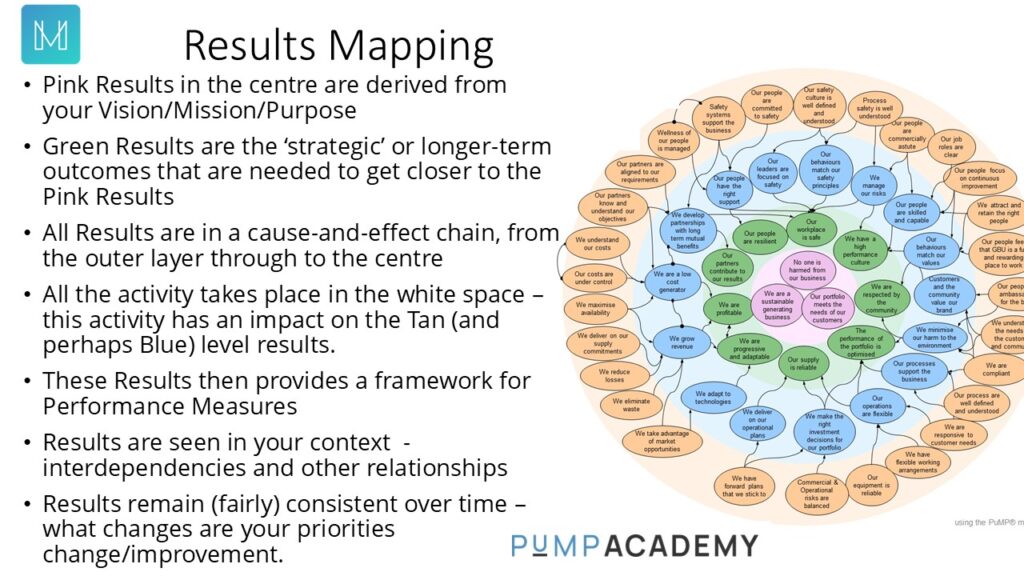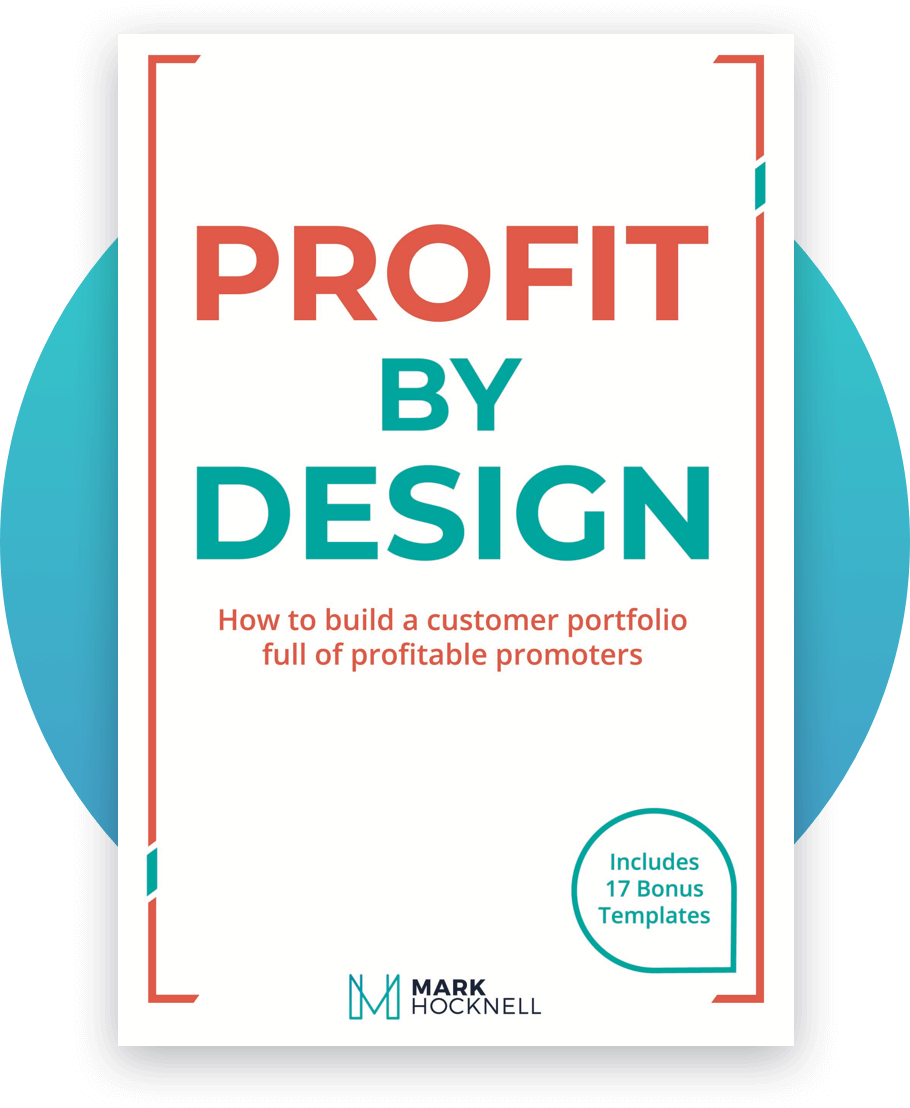Performance breakthrough seekers are early adopters who can see where their team or organisation could be, and perhaps should be. However, something needs to change before the breakthrough in performance can be achieved.
To achieve that performance breakthrough a shift in thinking is required. It’s a paradigm shift that unlocks the potential to see, and then realise that breakthrough in performance.
This means we need to shift the way we think about what we are doing, so that we can get people and our organisation on to the other side of that breakthrough.
I have seen this occur many times.
Let us explore two areas where new thinking provided performance breakthroughs; firstly, using the PuMP method, and secondly using the Profit By Design approach to customer centric business.
Performance breakthrough with new thinking using PuMP
But first, a note to recognise that these paradigm shifts were developed by Stacey Barr, the creator of the PuMP method. You can read more about PuMP in my blog here.
1. Focus on the result, before the action
Leaders and managers using PuMP often say that using the method shifts their thinking particularly from focusing on actions, to first being clear on what the result or outcome they want from the action. This shift in thinking from focusing on the actions to being clear on the outcome/result first, provides clarity for everyone on what the outcome/result is. Each result is written in clear, understandable language (no actions, no weasel words) and a single focus.
2. Results Mapping
Once we have the result statements, this allows leaders and managers to create a Results Map (below) which maps out the cause-and-effect relationships between results. Understanding causality is a key to gaining a performance breakthrough and performance improvement.
The Results Map then tells the story of strategy, from the actions in the whitespace of the Map, through the cause-and-effect results to the Results in the centre of the map that are the outcomes that come from the vision, mission and purpose of the organisation.

(Description of the PuMP Results Mapping Technique)
3. Performance measures are evidence of the Results
Performance measures are designed and selected for each result. Once we then know the baseline of each of these measures, we can monitor genuine changes based on the evidence from the measure. Measuring the impact of our actions on the results provides evidence of any significant breakthroughs in performance. Evidence, not opinions.
4. Performance measures are then used to learn and to improve
Not using measures to judge and blame people. No more KPIs (a measure with a target) to judge if a person is doing well. Throw out the rule book from last century that people need to “hit” their KPIs, or be disciplined.
The reason to measure anything is understand how that Result is tracking. And then, if we have prioritised that Result for change/improvement, the measures are used to understand if what we are doing is making an impact. This approach inspires curiosity around how to improve.
PuMP also then provides a set of techniques that enables us to create a measurement framework around the results on the Results Map.
The performance breakthrough:
- An outcomes-based approach to planning and improvement. No more arguments about pet projects, no more action lists that are not doable, no more wasted time around the water cooler arguing about what the strategy is… Clarity of purpose. Clarity of improvement priorities. A learning culture.
- A measurement framework, agreed and understood by all. No more lists of unachievable KPIs. No more KPIs being gamed to make it look like they are hit. No more hit-or-miss, succeed-or-fail conversations. No more employee performance reviews based on whether an arbitrary KPI was hit. A culture of curiosity about improvement.
- A measurement framework used by all. No more MESS (Many Excel Spreadsheets and Shouting). Agreement on priorities. Shared understanding and interpretation of performance. Shared understanding of when to observe and when to act. No more knee-jerk reactions to natural variation.
Anecdote: After this business implemented PuMP, I checked in with the CEO (about 6 months after their implementation) and asked how things were now… Their response was, “It’s quiet.” Okay, not what I had expected. Asking what that meant, their response was: “we used to have management meetings where everyone had their own spreadsheets and data and then we would debate and argue about what all this data meant. It often came down to me having to make a ‘captain’s call’ on what it all meant and what we needed to do. So, not a lot of agreement and engagement. Today, after implementing PuMP, it’s quiet. We all have a clear agreement on the priorities, we all understand the performance measures we have and we all have the same interpretation of what is happening. We are quietly learning how to improve our performance.”
The people that enable this level of change in their organisations are seeking the performance breakthrough that these paradigm shifts facilitate.
Performance breakthrough with new thinking about customers
This is also a paradigm shift for leaders and managers in businesses that realise their customer engagement (sales) efforts are filling their customer portfolio with people who have been sold to, or bought something to the customer’s advantage, rather than adding value for the business.
These paradigm shifts come from Profit By Design approach.
(Proft By Design key principles here)
1. Businesses exist for customers
This paradigm shift is about why the business exists. Often the business is focused on revenue and profitability which are important. But when revenue is the goal, any customer with an open wallet will do.
When we recognise that the business exists to create a customer portfolio full of profitable customers who are advocates of what they do, things change. Profit increases. Costs reduce. Customer advocacy increases. Customers give positive word of mouth and the customer portfolio continues to grow, with the “right” customers.
As Peter Drucker once said: “It is the customer who determines what a business is. It is the customer alone whose willingness to pay for a good or for services converts economic resource into wealth…what the business thinks it produces is not of first importance…”
(More on Peter Drucker’s view of the importance of a customer focus here)
This paradigm shift ensures the business focuses on engaging with the customers that will ensure long term profitability. Not just short-term revenue, which is often with the ‘wrong customers’. Because they changed their frame of thinking.
2. It’s all about people
Having a successful business is all about people. At business school the purchasing customer is often referred to as a sale, and ‘people’ sometimes gets discussed from a HR perspective. Similarly, start-ups focus heavily on their new idea, the new product or service they are providing, but soon realise if no one is interested, there is no business. Likewise, we focus on our systems and process to ensure they are supporting the business (which is still very important). However, it is people that bring this all to life.
There is an imperative to connect with our customers on value (they are people as well). As Simon Sinek famously stated, “People don’t buy what you do, they buy why you do it.” There is a two-way value exchange that takes place between the customer and the business. And this needs to be in balance.
Additionally, successful businesses understand the need to connect their people with a vision and purpose that is about people, their customers. No employee puts in the extra effort so that the senior leadership team receives a hefty bonus. Graham Weston, former CEO of Rackspace once declared: “We all want to be valued members, on a winning team that is on an inspiring mission.” (By the way, the PuMP Results Map is a great technique to connect your people to your “inspiring mission”).
This paradigm shift ensures that due consideration is applied to the long-term enduring aspects of the business, the customers and the people within the organisation. Rather than short term sales.
3. Not All Customers Are Equal
This should be obvious right…? However, most organisations see and refer to a generic customer. Anyone who engaged with you or bought something is a customer. But not all these customers are equal – in the value they represent to you – and in the way they receive value from you, which in turn directly affects their level of advocacy for you and what you do.
Recognising that not all customers are equal brings a paradigm shift that demands; a deeper understanding of this value exchange between the business and the customer. And then a categorising of customers in groups and sub-groups based on the value exchange.
From that point on you will, know your customer groups and your intent for each group. You will also, be able to articulate your value proposition for each specific customer group. Which in turn will increase the value within your portfolio of customers.
Anecdote: A B2B manufacturing and sales business realised a breakthrough in performance triggered by the Not All Customers Are Equal paradigm shift. After analysing their customer groups, they reorganised their account management team. Firstly, to provide a deeper level of joint planning with customers that valued this approach, and a more transactional approach with those customer-businesses that were that way inclined. The outcome was a lower cost to serve all customers, less complaints, and an increase in overall profitability through increased engagement with the ‘right’ customers. Taking a generic approach to organising their account management team left them with an ordinary result. Finetuning their organisation, based on an understanding of their customers gave them a performance breakthrough.
4. Businesses Are Systems That Deliver Value
Now that we have a deep understanding of our customer groups, the value they need from us and the value they provide back to us. We then need to see the business as the customer does. As a system that delivers value.
Design the optimal activity that ensures customers get the value they were promised and expect.
This is not about streamlining systems for the sake of it. It is not about making it quicker, just because we can. It is about aligning everything within the business to deliver the optimal experience and value for the customer.
This paradigm shift allows you to see the whole business as one system that delivers value for your chosen customer groups.

(The Nine Questions for Customer Centric Alignment)
Customer Centric Paradigm Shifts
The above paradigm shifts produce new ways of thinking that then become the essence of your Customer Strategy. Understanding the two-way value exchange between yourself and the various customer groups becomes the insight that focuses your efforts on creating a customer portfolio full of profitable promoters.
Read more on the customer centric princples.
Summing Up
The people that usually initiate a performance breakthrough in their organisations are breakthrough seekers. These people seek out new ways of thinking. They seek out new ideas and methods that challenge the thinking and status quo within their organisation.
Paradigm shifts are used by performance breakthrough seekers to trigger a shift in thinking. These techniques force us to think differently, and therefore produce different outcomes.
Call to action
Are you a performance breakthrough seeker? Be courageous.
Push ahead and use paradigm shifts, like the ones discussed, to change the thinking in your team or organisation.
Challenge the way you think to find a pathway to that performance breakthrough. Because once on the other side of the breakthrough, your world is a better place.
Are you seeking a performance breakthrough in your organisation…?
What is the breakthrough you seek…?
Feature Image Photo by Chris Flexen on Unsplash



